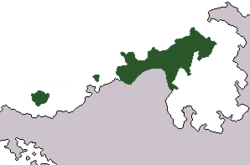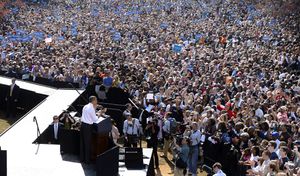Blepia: Difference between revisions
No edit summary |
No edit summary |
||
| Line 22: | Line 22: | ||
|estdate = 5 May 2017 | |estdate = 5 May 2017 | ||
|agerank = ''pending'' | |agerank = ''pending'' | ||
|area = | |area = 541440 km² | ||
|arearank = ''pending'' | |arearank = ''pending'' | ||
|pop = 6,000,000 (simulated) | |pop = 6,000,000 (simulated) | ||
Revision as of 03:17, 9 February 2018
| Duinacht na mBlepe (bl) Humanship of Blepia (en) | |||
| |||
| Motto: Blep leis na réaltaí (Blepian: Blepia to the stars) | |||
| Anthem: Cait na Laochra | |||

| |||
| Map versions | pending | ||
| Capital | Nídobhá | ||
| Largest city | Cuirfimid Báis, Mharú dom Anois | ||
| Official language(s) | Blepian English | ||
| Official religion(s) | None official Tocsaplasmóis granted cultural protection | ||
| Demonym | Blepian | ||
| - Adjective | Blepian | ||
| Government | Cellular democracy | ||
| - An Duine is Fearr | Glaisne mac Liatháin | ||
| - Ceann Daonna | Faoiltighearna nic Braonáin | ||
| - Legislature | Tionól Blepe | ||
| Establishment | 5 May 2017 | ||
| Area | 541440 km² | ||
| Population | 6,000,000 (simulated) | ||
| Active population | 14 | ||
| Currency | Blepian Líomóid (BLL) | ||
| Calendar | |||
| Time zone(s) | |||
| Mains electricity | |||
| Driving side | |||
| Track gauge | |||
| National website | [1] | ||
| National forum | none | ||
| National animal | Ginger cat | ||
| National food | Lemon | ||
| National drink | Lemon tea | ||
| National tree | Evergreen tree | ||
| Abbreviation | BLP | ||
Blepia (Blepian: An Bhlep) is a nation located on Apollonia northeast of Glanurchy Island. Blepia has existed since May 2017 under a democratic government.
History
Blepia's history, albeit very short, is still interesting and eventful, having its fair share of controversy and conflict. It mainly revolves around the rapid development and democratization of the area inhabited by the Blepians.
Origins of Blepia
The first mention of Blepia in writing can be dated back to the year 1832 AD and a record keeping book belonging to a village now known as Mharú dom Anois. At the time of the writing of this book Blepia was fractured into many rival clans and city states, but was relatively peaceful.
In 1830 AD the Blepian language existed and was spoken over an area three times the size of modern Blepia. However as time marched on society marched forward and the Blepian language was considered "uncivilized" by academics of the time, and today the area where it is spoken as a first language has been shrunk to only the remote areas around the military installation Ullmhaigh Chun-Bás (although most Blepians do learn it before the conclusion of secondary school). However it is currently making a resurgence as small parts of Nídobhá introduce solely Blepian signage for the first time in 150 years.
The usage of the word Blepia in that book is assumed to be referring to the area speaking the Blepian language and adhering to the Blepian culture, and it is the oldest artifact of Blepian national identity.
Blepian Unification
Starting in the 1990s Blepian national identity grew to engulf the identities people had with their regional states. Thus in the year 2014, a regional state (whose capital was Nídobhá) began to invade other states around it with the goal of unifying Blepia. Due to its overly aggressive behavior and the attitudes of most other regional leaders towards a united Blepia at the time a coalition was quickly formed against it and it was militarily defeated. This sparked uprisings in all major cities across Blepia demanding a deal for unification. Initially the regional governments ignored them but they continued for weeks on end with tens of thousands of Blepians in the streets each evening chanting and singing. The elites realized that they could not ignore this forever and if they did not unify there would be an uprising on their hands and their heads would end up on pikes. Therefore, a conference was held in Mharú dom Anois with seven regional leaders attending. After only a few days of negotiations a deal was agreed that all states northwest of the Uí Muireasa line (now the border of mainland Blepia) or on the islands of Glanurchy or Fifty Elks. The Treaty of Mharú dom Anois officially came into effect on the 5th of May 2017 forming the Humanship of Blepia.
First Days of the Humanship
The Humanship of Blepia had lots of issues after its foundation. It had no predecessor state since it was a union of a few dozen other states which all had their own forms of government, and a form of government could not be agreed on in the Treaty. Therefore a referendum was held with a campaign period of one week by the Provisional Blepian Government. From the start, the idea of cellular democracy was very popular as it would allow for the easy growth of regional parties while still maintaining a unitary government and a central Blepian parliament. It eventually won 67% of the vote. After this the royal family of the previous Kingdom of Mharú dom Anois holed up in Pálás Buí with all the forces they could muster. Due to the overwhelming strength of this force compared to the non-existent army of the government at that time known as the Poblacht na mBlepe the government was forced to accept them as figurehead monarchs and allow them to keep their palace and some of their land holdings, thus changing the government to the Duinacht na mBlepe.
Parliamentary Elections of July 2017
Once all the issues had been ironed out, the new unified Blepian government was ready to progress. Thus the campaign period for the first Blepian parliamentary elections begun on the 7th of July 2017, for a term intended to last 2 years. Having been angered by the military imposition of monarchy just a few months earlier, the chances of any monarchist parties winning were out of the question, and with the memory of the Unification Wars still fresh, nationalists had no chances. The right wing socially liberal party Solas na Saoirse performed near-magically in the run-up to the final debate but their party leader was caught up in a monumental blunder on live national television greatly diminishing their support. A Toxoplasmosist establishment party, An tAontas Daonlathach Tocsaplasmóis gained a large amount of seats from rural and religious voters while a broad tent leftist party Páirtí an Phobail also did well forming a government with minor Green and Social Liberal parties.
Geography
Blepia is located on the continent of Apollonia northwest of Glanurchy Island and has a continental climate with temperatures year-round averaging 5 degrees Celsius. The Blepian mainland is bordered on the west by the Gulf of Souls, on the south by the Uí Muireasa line, and on the north and east by the Northern Sea which engulfs the two constituent islands of Blepia, Glanurchy Island and Fifty Elk Island.
Administrative divisions
The cellular democratic system of Blepia splits the nation into ninety-four second-level councils which serve as governments for a area centered around a town, and they can be compared to American counties or European municipalities. Second-level councillors from several councils vote for the members of first-level councils. Blepia is divided into ten first-level regions, each of which have a council of fifty members. First-level regions usually follow the borders of previously existing states but can also be drawn on account of physical or cultural barriers. The first-level councils generally act like regional governments do in other countries, governing their specific part of the country with the caveat that it is still officially a unitary state.
Regions
Blepia currently holds sovereignty over ten regions, all of which were united to create Blepia at the Treaty of Mharú dom Anois. Their main role is to facilitate regional nationalists but they also provide effective local government.
| Flag | Region | Capital | Number (on map) | Blepian control since |
|---|---|---|---|---|
| Oileáin Thiar | Cuirfimid Báis | 1 | May 5 2017 | |
| Druim Thuaidh | Baile gan aon Chúis | 2 | May 5 2017 | |
| Novatica | Ainm aistrithe go Dona | 3 | May 5 2017 | |
| Tuirlingthe | Cén fáth a bhfuil mé Anseo | 4 | May 5 2017 | |
| Ullmhaigh | Baile Ullmhaigh Chun-Bás | 5 | May 5 2017 | |
| Naomh Albain | Cuain Naomh Albain | 6 | May 5 2017 | |
| Lárnach | Sráidbhailte Reoite | 7 | May 5 2017 | |
| Lár Soir | Theas Nídobhá | 8 | May 5 2017 | |
| Nídobhá | Nídobhá | 9 | May 5 2017 | |
| Mharú dom Anois | Mharú dom Anois | 10 | May 5 2017 |
Government and politics
The government of Blepia is as complicated as its people, and according to international statistics, over seventy-nine thousand kilograms of hair have been removed from individual heads as a result of its complexity. Officially, it is a cellular democracy, with Best Human Glaisne mac Liatháin as head of state and Head Human Faoiltighearna nic Braonáin as head of government.
Best Human
Best Human of Blepia is a title gained by the mac Liatháin family as a result of the Pálás Buí incident. The Best Human is generally only a ceremonial title, created to ensure that the previous royal family of Mharú dom Anois could keep their palace and most of their assets. All members of the Tiónol Blepe must take an oath of loyalty to the Best Human before taking office, and consent of the Best Human is required before a war is declared. In addition, the Best Human is the ceremonial leader of the Blepian Forces.
Head Human
The Head Human of Blepia is the head of government of Blepia and the leader of the party with the most seats in the Tiónol Blepe. They are the leader of Blepia and have the power to veto bills of the Tiónol as well as declare states of emergency and make executive orders during them. The Head Human was created after the Blepian government referendum of May 2017 voted in favour of cellular democracy.
Tionól Blepe
The Tionól Blepe is the parliament of Blepia composed of 100 members, 10 elected by each first-level council. Translated to English, it means "Blepian Assembly". Any MA (Member of the Assembly) from the largest party in the Assembly may become the Speaker





